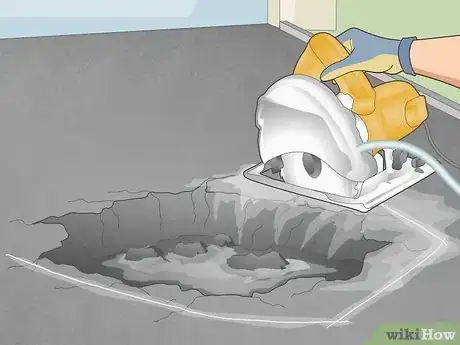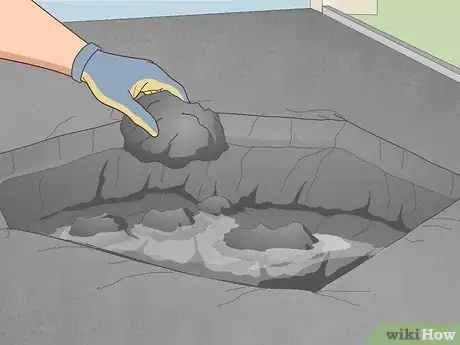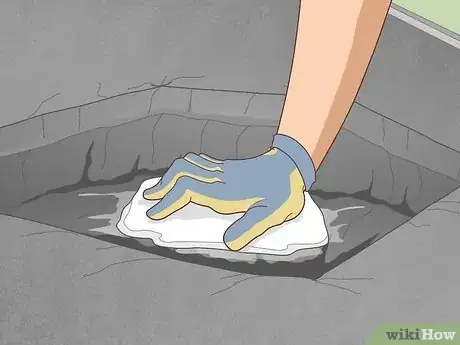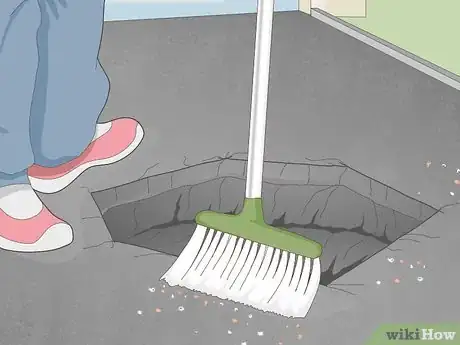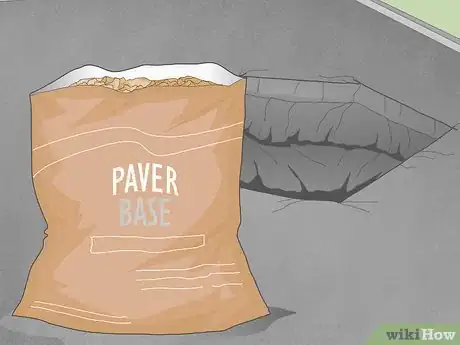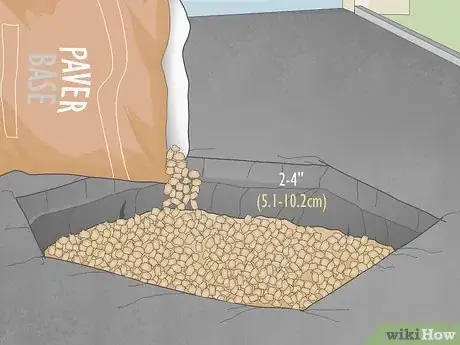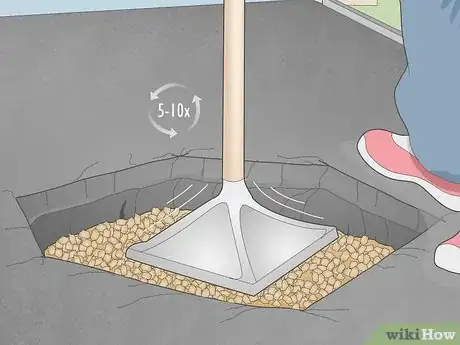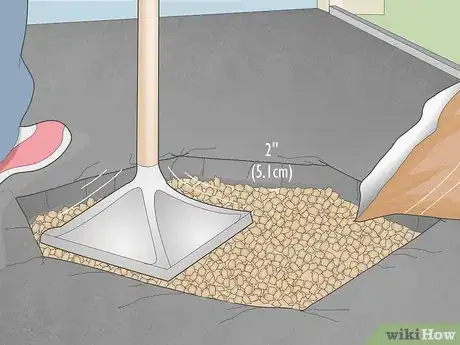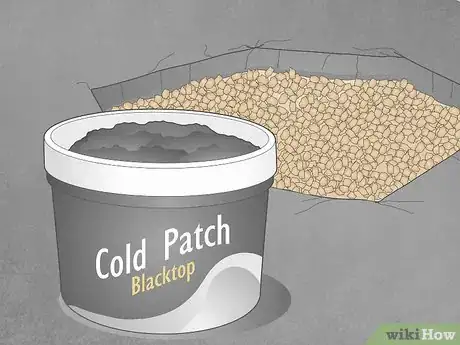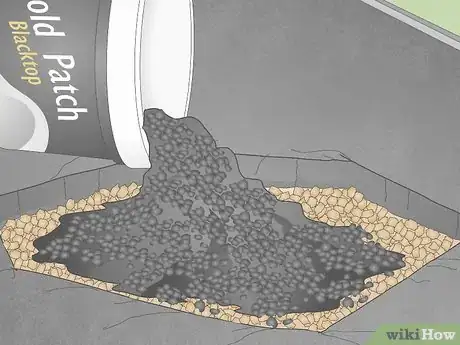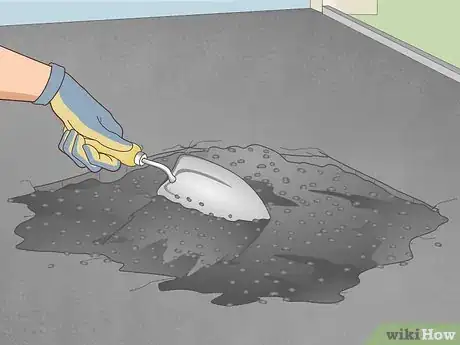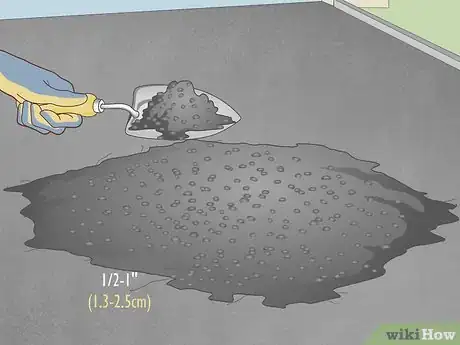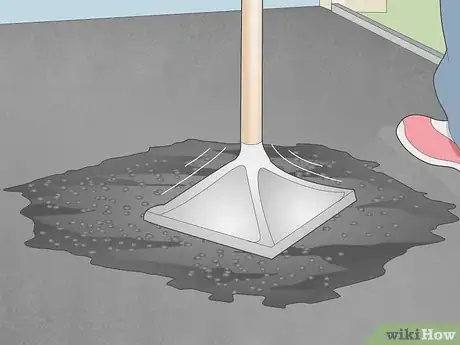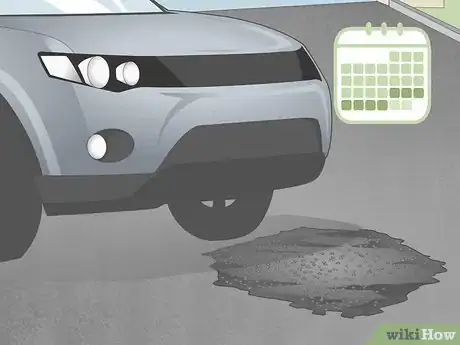This article was co-authored by wikiHow staff writer, Eric McClure. Eric McClure is an editing fellow at wikiHow where he has been editing, researching, and creating content since 2019. A former educator and poet, his work has appeared in Carcinogenic Poetry, Shot Glass Journal, Prairie Margins, and The Rusty Nail. His digital chapbook, The Internet, was also published in TL;DR Magazine. He was the winner of the Paul Carroll award for outstanding achievement in creative writing in 2014, and he was a featured reader at the Poetry Foundation’s Open Door Reading Series in 2015. Eric holds a BA in English from the University of Illinois at Chicago, and an MEd in secondary education from DePaul University.
There are 8 references cited in this article, which can be found at the bottom of the page.
This article has been viewed 18,684 times.
Learn more...
Before you break out the repair tools, double-check to make sure that the pothole is actually on your property. If it isn’t, you cannot repair the pothole on your own, but you can certainly contact your local government to get a repair crew to do it for you. If the pothole is on your property, repairing it is actually pretty easy. All you need is a shovel, putty knife, a tamper, and some materials to fill the hole in. This repair shouldn’t cost more than $50-150 depending on the tools you already have and the size of your pothole. It’s also not a difficult repair; this process shouldn’t take more than 1-2 hours.
Steps
Cleaning and Cutting the Hole
-
1Cut the jagged edges out with a wet saw if you want a cleaner repair. Put on gloves, protective eyewear, and a dust mask. Put a diamond blade on a wet saw and hold the blade away from you. Turn the saw on and let the blade come up to speed. Cut directly around the edges of the hole to remove any jagged or rough edges. Shape the edges of the hole so that it’s symmetrical. To make things easy, you can cut it into a circle, square, or rectangle.[1]
- Cutting out the uneven edges will make the repair last longer. If the asphalt is symmetrical, pressure will be evenly distributed over the repair job when you walk or drive over it. The upside isn’t so important that this is mandatory, though.
Tip: This is a key element for road repairs, but you really don’t need to do this if you’re just repairing a driveway or parking space. You can if you want, but it’s not essential. It’s also not worth doing if you’re unfamiliar with power tools.
-
2Throw out any of the larger rocks or debris sitting in the hole. Keep your gloves on and reach down into the hole to lift out any big chunks of asphalt. Toss them into a pile 3–6 feet (0.91–1.83 m) away from you to collect them for disposal. Toss out any junk, rocks, or large chunks of dirt that are sitting inside of the pothole.[2]
- The cleaner you can get the hole, the less likely it will be that the repair collapses or sinks in on itself.
Advertisement -
3Dig out any soft debris using a shovel or trowel to prep the hole. Grab a shovel for a hole bigger than 1 by 1 foot (0.30 by 0.30 m) and a hand trowel for anything smaller. Dig the blade into the ground to pull up any soft dirt and remove it from the hole. Continue to remove dirt and loose asphalt until you reach firm ground.[3]
- You may not need to dig anything up if the ground underneath is already firm.
- The easiest way to collect the dirt or dust is to pour it into the same pile you made with the bigger chunks of rock. This way you only have one pile to clean up when you’re done.
-
4Soak up any water you come across using absorbent rags. Potholes often form because water seeps into the ground underneath and weakens the foundation of the asphalt. If you come across any puddles, soak the water up with an absorbent rag. Then, remove any moist soil or stones. Let the hole air dry if it’s really damp.[4]
- You can certainly repair a damp pothole, but the repair won’t last as long. You may only get 3-4 years out of the repair, while a dry repair may stay stable for up to 10 years.
-
5Sweep the area surrounding the hole to keep rocks from falling in. Once you’ve cleaned the hole out, give the area surrounding the hole a good sweeping. Use a standard broom to wipe the pebbles, dirt, and dust away from the hole.[5]
- You can throw out all of the stones and dust now or wait until you’re done.
Adding Your Paver Base
-
1Pick up enough paver base to fill in the pothole. Also known as paver stone, paver base is a combination of crushed stone and sand. Stop by a construction supply store and pick up your paver base. It’s pretty easy to visually determine how much paver base you need, but grab an extra bag just to be safe. You’re going to compact the base with a tamper so you may need a little more than you think.[6]
- Paver base is extremely inexpensive. You can pick find the standard 40 pounds (18 kg) bags for $5-6.
Tip: It lists the amount of space the paver base will fill in on the container if you want to get scientific with the repair. Generally speaking, 40 pounds (18 kg) will fill in 1⁄2 cubic foot (14,000 cm3).
-
2Fill the bottom 2–4 inches (5.1–10.2 cm) of the hole with the paver base. Rip open your bag of paver base and pour it directly into the pothole. Fill in the bottom 2–4 inches (5.1–10.2 cm) of the hole with your paver base and spread it out by hand. Wear gloves while doing this to avoid cutting your hands on a sharp piece of paver base.[7]
- You don’t need to be exact about this, but you can stick a ruler into the stone to measure it if you really want to.
-
3Compact the paver base by hitting it with a tamper 5-10 times. Once you’ve added your first layer of paver base, grab a tamper. A tamper is just a heavy plate with a pole on top, and you can rent one from a construction supply store for $10-25 if you don’t have one. Spread your feet out and use the pole to lift the plate over the paver base. Slam the plate into the stone to compact it. Do this 5-10 times to condense each portion of the paver base.[8]
- There are electric tampers that make this process much easier, but you really don’t need one of these for a pothole. Electric tampers are designed mainly for leveling foundations and driveways, but it’s overkill for a small hole.
-
4Repeat this process until you get within 2 inches (5.1 cm) of the top. Keep pouring 2–4 in (5.1–10.2 cm) layers of the paver base into the pothole. For each layer your pour into the hole, spread it out by hand to make it flat and compress it with your tamper. Hit each portion of the paver base 5-10 times to compact it into the hole.[9]
- Take breaks every 10-15 minutes. The tampering can take quite a bit of effort, so you may wear yourself out if you don’t take some breaks.
Filling in the Pothole with Blacktop
-
1Pick up enough cold patch blacktop repair to fill in the surface. The name is kind of confusing, but “cold patch” refers to asphalt that doesn’t need to be heated or mixed and “blacktop repair” is the official name for repair asphalt. Stop by a construction supply store and pick up enough blacktop to cover the top of the hole.[10]
- The cold patch blacktop repair will typically last 5-10 years.
- Blacktop repair is often sold as “asphalt patch” or “cold asphalt.” Any of these products will work.
- The blacktop will cost $15-30 for every 50 lb (23 kg) bag you buy. A single 50 lb (23 kg) bag will cover roughly 1 cubic foot (28,000 cm3).
- If you get “hot mix” or real asphalt, you need an industrial mixing machine to activate the asphalt. Since these machines cost $600-8,000, you’re better off just getting the cheaper stuff.
Tip: If possible, look for a brand that has “DOT approved” on the label. Any blacktop that is DOT approved has been used by a Department of Transportation to make municipal repairs. These blacktops tend to be very high-quality.
-
2Dump the blacktop on top of the paver base to fill the hole. Turn the container of blacktop upside down over the hole. Tap the back of the container to shake the blacktop loose and dump it in the middle of the pothole.[11]
- This stuff is pretty thick, so you may need to hit the back of the container with a hammer or the back of your putty knife to knock it out.
-
3Spread the blacktop around with a hard putty knife or shovel. Use the edge of your putty knife or shovel to spread the blacktop around over the surface of the pothole. Drag the shovel or putty knife back and forth over the blacktop to slowly push it around. Get the blacktop as even as you can.[12]
-
4Add or remove blacktop to make it stick out roughly 1⁄2–1 in (1.3–2.5 cm). Once you spread the blacktop out, check to see if it sticks out a little on the ground. Add more blacktop as needed by pouring it out, or remove excess blacktop by scraping it off with your putty knife. The goal is to add enough blacktop to make it stick out 1⁄2–1 inch (1.3–2.5 cm) past the surrounding asphalt.[13]
- The tamper will compress the blacktop, so if you don’t add a little extra the blacktop will dip below the surface of the surrounding asphalt.
-
5Tamper the blacktop down the same way you tampered the paver base. Grab your tamper again and lift it over the blacktop. Spread your feet out away from the base of the tamper and slam it into the pothole. Drop the tamper into each portion of the blacktop 15-20 times to compact it and make it sit flush with the surrounding asphalt.[14]
- You may not get it perfect, but that’s okay. It’s hard to make it sit perfectly flat without an industrial roller.
-
6Wait at least 3-4 weeks before driving or walking over the repair. If your pothole was in a driveway, side road, or parking space, wait a few weeks before driving over it again. The blacktop takes a long time to cure and settle, and you may damage the pothole if you drive over it before it has finished drying out.[15]
Warnings
- If you use a wet saw, do not skip out on the dust mask or protective eyewear. A loose shard of asphalt may pop up off of the blade when you’re cutting it.⧼thumbs_response⧽
- Keep your feet at least 1.5 feet (0.46 m) away from the plate of the tamper while you’re slamming it into the ground. You don’t want to accidentally hurt your foot!⧼thumbs_response⧽
Things You’ll Need
- Gloves
- Shovel
- Trowel
- Paver base
- Blacktop
- Putty knife
- Tamper
- Protective eyewear (optional)
- Dust mask (optional)
- Wet saw (optional)
- Diamond blade (optional)
References
- ↑ https://www.thisoldhouse.com/driveways/21017057/how-to-repair-an-asphalt-pothole-in-driveway
- ↑ https://www.thisoldhouse.com/driveways/21017057/how-to-repair-an-asphalt-pothole-in-driveway
- ↑ https://www.thisoldhouse.com/driveways/21017057/how-to-repair-an-asphalt-pothole-in-driveway
- ↑ https://thenewswheel.com/5-kinds-pothole-repair/
- ↑ https://youtu.be/WlLfAHOyrcQ?t=33
- ↑ https://www.thisoldhouse.com/driveways/21017057/how-to-repair-an-asphalt-pothole-in-driveway
- ↑ https://www.thisoldhouse.com/driveways/21017057/how-to-repair-an-asphalt-pothole-in-driveway
- ↑ https://www.thisoldhouse.com/driveways/21017057/how-to-repair-an-asphalt-pothole-in-driveway
- ↑ https://www.thisoldhouse.com/driveways/21017057/how-to-repair-an-asphalt-pothole-in-driveway
- ↑ https://www.thisoldhouse.com/driveways/21017057/how-to-repair-an-asphalt-pothole-in-driveway
- ↑ https://youtu.be/WlLfAHOyrcQ?t=73
- ↑ https://youtu.be/WlLfAHOyrcQ?t=126
- ↑ https://youtu.be/WlLfAHOyrcQ?t=80
- ↑ https://youtu.be/WlLfAHOyrcQ?t=191
- ↑ https://www.thisoldhouse.com/driveways/21017057/how-to-repair-an-asphalt-pothole-in-driveway
- ↑ https://www.creators.com/read/heres-how/06/19/repair-potholes-in-an-asphalt-driveway-yourself
